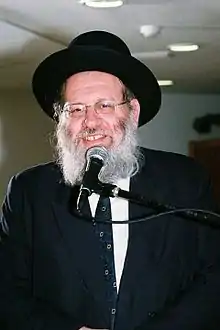
David Avraham Spektor, also spelled Schpektor (9 Av 5715 – 12 Tishrei 5774) (9 August 1955 – 16 September 2013) was a Dutch–born Israeli rabbi.[1] He was born in Amsterdam, the Netherlands and emigrated to Israel in 1973, after the Yom Kippur war. Spektor studied at several yeshivas for ten years, primarily at Yeshivat Mercaz HaRav and the Meretz Kollel. He was ordained by the Chief Rabbinate of Israel as both a neighbourhood rabbi (Rav Shechunah) and city rabbi (Rav Ir).
Career
Spektor positions included being an army chaplain with the rank of lieutenant in artillery, a rabbi at Hebrew University of Jerusalem, rabbi of the Nokdim community in Gush Etzion, and a lecturer in Michlelet Emunah college for women in Jerusalem.
In 1998 Spektor was appointed the Ashkenazic rabbi of the Givat Sharett neighborhood of Beit Shemesh.[2][3] He was also a local rabbinate in Beit Shemesh.
Spektor died on 12 Tishrei 5774 (16 September 2013) after having cancer for two years.
Publications
Spektor's books include:
- El-David Responsa on Halachic questions
- Tahorat Eretz Yisrael on ritual purity in halacha and thought
- Torat Eretz Yisrael[4] on the weekly portion
- Sefer HaGabbai
- Beit Shemesh,[5] the Biblical town
- Herodian Responsa
- Drama, Art and Graphic Design Responsa[6]
His wife, Rabbanit Chaya Spektor has also published a book:
- The Value of Childbirth in Jewish Sources
References
- ↑ "Rabbi David Avraham Spektor Passes Away - Jewish World - News". Israel National News. 2013-09-16. Retrieved 2013-09-20.
- ↑ "Teach, don't burn". Jerusalem Post (via HighBeam Research). December 28, 2001. Archived from the original on June 11, 2014. Retrieved 13 August 2012.
- ↑ Singer, Saul (2003-09-30). Confronting Jihad: Israel and the world after 9/11. Cold Spring Press : distributed by Simon & Schuster. p. 252. ISBN 9781593600013. Retrieved 13 August 2012.
- ↑ Lichtman, Moshe D. (2006-12-01). Eretz Yisrael in the Parashah: Essays on the Centrality of the Land of Israel in the Torah : Plus Commentary on Nearly Every Reference to the Holy Land in the Torah. Devora Publishing. pp. 214–. ISBN 9781932687705. Retrieved 13 August 2012.
- ↑ Enkin, Ari N. (2008-05-30). Dalet amot: halachic perspectives. Gefen Publishing. p. 193. ISBN 9789652294098. Retrieved 13 August 2012.
- ↑ Alexenberg, Mel (2011-04-15). The Future of Art in a Postdigital Age: From Hellenistic to Hebraic Consciousness - Second Edition. Intellect Books. pp. 210–. ISBN 9781841503776. Retrieved 13 August 2012.